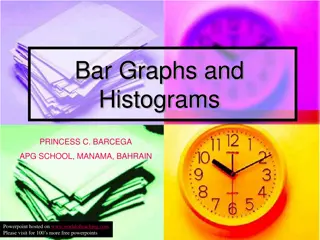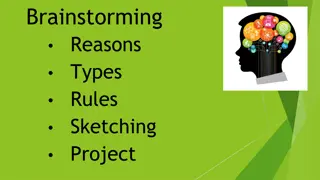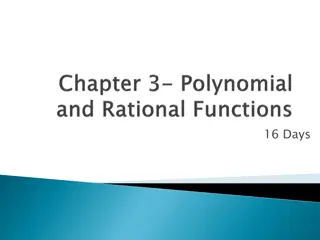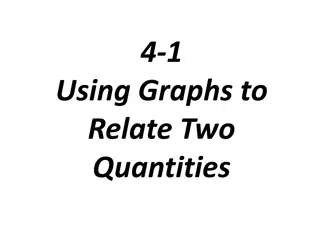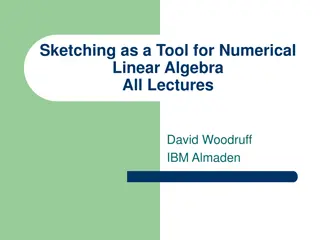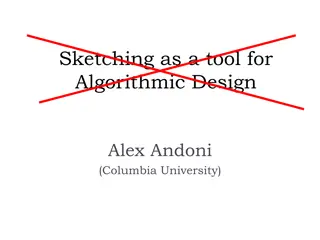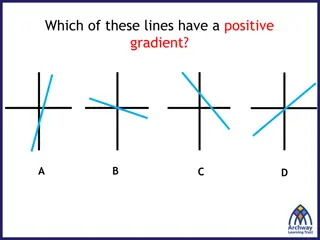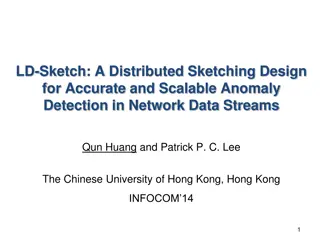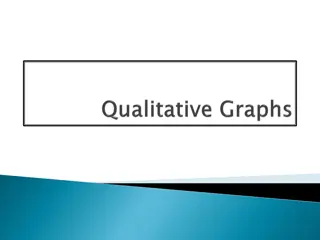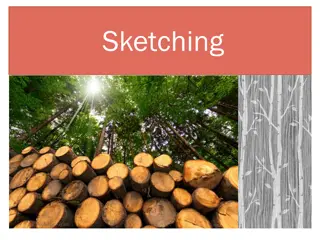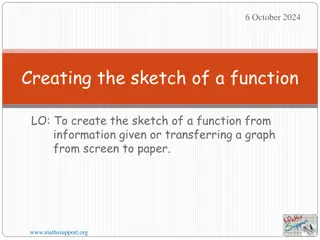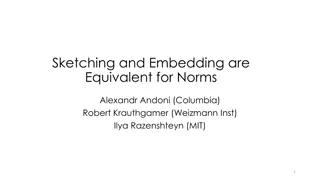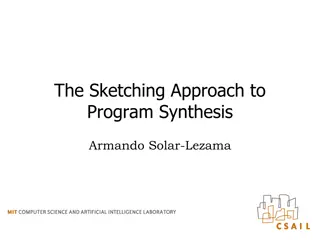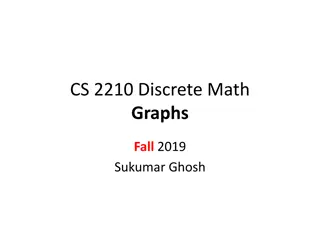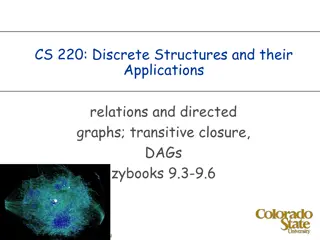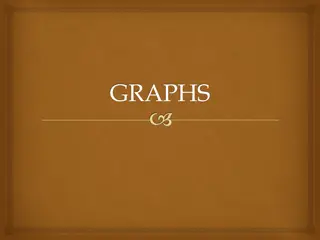4 step sketch
A 4-step sketching process to generate and refine ideas through note-taking, idea generation, rapid sketching, and solution sketching.
0 views • 11 slides
Understanding Expander Families and Ramanujan Graphs
An introduction to expander families and Ramanujan graphs by Tony Shaheen from CSU Los Angeles. The discussion covers the concept of regular graphs, motivation behind expander families, communication networks, and the goal of creating an infinite sequence of d-regular graphs optimized for communicat
0 views • 54 slides
Exploring Product and Knowledge Graphs for Enhanced Information Retrieval
Dive into the world of product and knowledge graphs, uncovering the journey to a rich product graph, examples of knowledge graphs for songs, and the mission to provide comprehensive information on products and related knowledge. Discover use cases ranging from information provision to enhancing sear
3 views • 76 slides
Exploring Various Types of Graphs in Statistics Education
Delve into the world of data visualization with slow reveal graphs, column graphs, pictographs, dot plots, divided bar graphs, sector graphs, line graphs, and stem-and-leaf plots. Engage in observations and wonderings to enhance statistical comprehension and analytical skills.
1 views • 8 slides
Exploring Graphs: An Introduction to Data Visualization
This chapter delves into various types of graphs used in data representation, such as bar graphs, pie graphs, histograms, line graphs, and linear graphs. It explains the purpose and structure of each graph type, along with practical examples. Additionally, it covers the Cartesian system for locating
0 views • 15 slides
Understanding Bar Graphs, Double Bar Graphs, and Histograms
Bar graphs are useful for displaying and comparing data, while double bar graphs help compare two related datasets. Histograms show the distribution of data. Learn how to interpret and create these visual representations effectively with examples provided.
0 views • 20 slides
Primal-Dual Algorithms for Node-Weighted Network Design in Planar Graphs
This research explores primal-dual algorithms for node-weighted network design in planar graphs, focusing on feedback vertex set problems, flavors and toppings of FVS, FVS in general graphs, and FVS in planar graphs. The study delves into NP-hard problems, approximation algorithms, and previous rela
0 views • 17 slides
Understanding Graphs of Straight Lines and Equations
Learn how to graph equations and find equations from graphs of straight lines. Explore tables of values, plotting points on a coordinate plane, drawing lines through points, and identifying relationships between graphs and algebraic expressions. Discover the gradient-intercept form of a straight lin
0 views • 14 slides
Understanding Speed vs. Time Graphs: Analyzing Acceleration and Motion
Explore the concept of speed vs. time graphs and learn how to recognize acceleration, interpret speed, analyze motion, and calculate acceleration from the slope of the graph. Discover the characteristics of graphs showing constant acceleration, varying acceleration, and deceleration. Engage in drawi
0 views • 19 slides
Foster Creativity Through Brainstorming and Sketching Activities
Embrace brainstorming techniques like free-for-all and forced association to generate innovative ideas. Follow rules of no criticism and encourage quantity over quality. Utilize sketching to visually communicate concepts effectively. Engage in fun activities like building the Tower of Benton to appl
0 views • 7 slides
Understanding Polynomials and Graphs through Real-World Analogies
Explore the relationship between mountain ranges and polynomials, and learn how to apply the Intermediate Value Theorem to find zeros of polynomial functions. This guide covers concepts like the Interval Value Theorem, sketching graphs of higher-degree polynomials, and constructing tables to analyze
3 views • 85 slides
Understanding Radians: Measurement, Arc Length, Sectors, and Trigonometry Equations
This content covers various topics related to radians, including radian measurement, arc length, areas of sectors and segments, and solving trigonometric equations. It also includes small angle approximations and worked examples on converting angles to radians and degrees, sketching graphs, finding
0 views • 40 slides
Geographical Skills: Aerial Photographs, Charts, Graphs and Infographics
Aerial photographs are key tools for interpreting land surfaces, with vertical and oblique types used for different perspectives. Locating places on photographs involves dividing them into sections and understanding directions. Sketching aerial photographs requires creating a frame and dividing sect
0 views • 30 slides
Representation of Abstract Groups through Graphs
Explore the representation of abstract groups as automorphism groups of graphs, touching on topics such as the existence of graphs whose automorphism groups are isomorphic to given abstract groups, the cardinality of connected graphs satisfying specific properties, and questions regarding the cardin
0 views • 16 slides
Understanding Low Threshold Rank Graphs and Their Structural Properties
Explore the intriguing world of low threshold rank graphs and their structural properties, including spectral graph theory, Cheeger's inequality, and generalizations to higher eigenvalues. Learn about the concept of threshold rank, partitioning of graphs, diameter limits, and eigenvectors approximat
0 views • 22 slides
Exploring Types of Graphs for Data Representation
Different types of graphs, such as line graphs, scatter plots, histograms, box plots, bar graphs, and pie charts, offer diverse ways to represent data effectively. Understanding when to use each type based on the data being collected is essential for insightful analysis. Scatter plots are ideal for
2 views • 37 slides
Exploring Relationships Through Graphs
Learn how to analyze and relate two quantities using graphs, analyze data presented in tables and graphs, and sketch graphs representing various scenarios such as the movement of a model rocket or a playground swing. The visuals provided will help you understand how to interpret and draw graphs in d
2 views • 7 slides
Sketching Techniques for Efficient Numerical Linear Algebra on Massive Data Sets
Explore how sketching methods can be applied in numerical linear algebra to handle massive data sets efficiently. David Woodruff of IBM Almaden discusses using randomized approximations for algorithms aiming for nearly linear time complexity. Applications include analyzing internet traffic logs, fin
0 views • 95 slides
Sketching as a Tool for Algorithmic Design by Alex Andoni - Overview
Utilizing sketching in algorithmic design, Alex Andoni from Columbia University explores methodologies such as succinct efficient algorithms, dimension reduction, sampling, metric embeddings, and more. The approach involves numerical linear algebra, similarity search, and geometric min-cost matching
0 views • 18 slides
Understanding Sketching and Constraints in SolidWorks
Explore the process of sketching in SolidWorks, from defining dimensions and geometric constraints to understanding sketch states. Learn how to manage underdefined, fully defined, and overdefined sketches, along with tips for adding, editing, and deleting constraints effectively.
0 views • 16 slides
Understanding Correlation in Scatter Graphs
In this content, various graphs are used to demonstrate the concept of correlation in scatter graphs. It discusses positive, negative, and no correlation, showcasing how one variable affects the other. Examples and explanations are provided to help understand the relationships between different sets
0 views • 17 slides
Symmetric Chromatic Function for Voltage Graphs
Exploring the concept of a Symmetric Chromatic Function (SCF) for voltage graphs involves proper coloring conditions for edges and vertices, edge polarization functions, and decomposing voltage graphs into disconnected and connected squiggly graphs. The SCF allows for determining the number of ways
0 views • 7 slides
Year 12 Autumn Scheme of Learning for St. Anthony's and St. Aidan's 6th Form
Explore the comprehensive Year 12 Autumn Scheme of Learning for St. Anthony's and St. Aidan's 6th Form, covering topics such as algebraic manipulation, quadratic equations, simultaneous equations, graphs, statistical sampling, differentiation, integration, and statistical hypothesis testing. Dive in
0 views • 13 slides
Uniquely Bipancyclic Graphs by Zach Walsh
Research conducted at the University of West Georgia focused on uniquely bipancyclic graphs, defined as bipartite graphs with exactly one cycle of specific lengths determined by the order. Uniquely bipancyclic graphs have special properties, including having a Hamiltonian cycle and a specific order
0 views • 18 slides
LD-Sketch: Distributed Sketching Design for Anomaly Detection in Network Data Streams
LD-Sketch is a novel distributed sketching design for accurate and scalable anomaly detection in network data streams, addressing challenges such as tracking heavy keys in real-time across a vast key space. By combining high accuracy, speed, and low space complexity, LD-Sketch enables efficient heav
0 views • 25 slides
Understanding Graphs for Mathematical Interpretation
Explore how students can grasp information through graphical formats and convert it into mathematical graphs. Learn about qualitative graphs, functions, axes, and more. Delve into exercises matching graphs with situations and drawing graphs for given scenarios like plane take-off, biking, and snowbo
0 views • 16 slides
Adjacency Labeling Schemes and Induced-Universal Graphs
Adjacency labeling schemes involve assigning L-bit labels to vertices in a graph for efficient edge determination. The concept of induced-universal graphs is explored, where a graph is universal for a family F if all graphs in F are subgraphs of it. Theorems and lower bounds related to adjacency lab
0 views • 24 slides
Understanding Kinematics Graphs in Physics
Explore the concepts of kinematics graphs through diagrams and descriptions. Learn to interpret distance-time, velocity-time, and speed-time graphs. Understand key parameters such as displacement, initial velocity, final velocity, constant acceleration, and time spent on different parts of a journey
0 views • 33 slides
Mastering Sketching Techniques: Oblique, Isometric, and Shading Tips
Learn how to create 3D effects in your sketches using oblique and isometric sketching methods, along with shading techniques to add depth and dimension. Master the art of drawing cubes and other shapes with step-by-step instructions and visual examples. Enhance your sketching skills with tips on hat
0 views • 4 slides
Sketching Graphs of Functions: Techniques and Examples
The art of sketching graphs of functions involves representing specific shapes and behaviors through labeled diagrams. This lesson highlights key details to keep in mind when sketching functions, such as labeling axes, maximum and minimum values, intercepts, symmetry, and asymptotes. Two examples of
0 views • 16 slides
Sketching and Embedding Equivalence for Norms in Metric Spaces
Sketching and embedding techniques are explored by Alexandr Andoni, Robert Krauthgamer, and Ilya Razenshteyn in the context of metric spaces. This research delves into the equivalence between sketching and embedding for various norms, addressing topics such as compressing high-dimensional objects, s
0 views • 15 slides
The Sketching Approach to Program Synthesis
The Sketching Approach to Program Synthesis, presented by Armando Solar-Lezama, introduces a new programming model focused on localized synthesis, allowing programmers to control implementation strategy. Sketches, programs with holes, enable constraining the set of solutions considered by the synthe
0 views • 42 slides
Enhancing Efficiency in Sketch-based Monitoring for Programmable Switches
SketchLib introduces advancements in sketching algorithms to enable efficient monitoring on programmable switches. The tool bridges gaps between existing sketches for CPUs and programmable switches, offering resource optimizations and API calls to enhance performance and reduce resource consumption
0 views • 20 slides
Understanding Graphs and Their Models
Explore the world of graphs through definitions, types, and special features. Learn about vertices, edges, simple and multiple graphs, directed and undirected graphs, and more. Discover the terminology and special types of graphs along with basic concepts and properties.
0 views • 33 slides
Understanding Sketching and Locality Sensitive Hashing in Data Mining
Explore the concepts of Jaccard Similarity and Cosine Similarity in data mining, along with their applications in recommendation systems and finding near-duplicates. Discover how Sketching and Locality Sensitive Hashing techniques help in efficiently identifying similar items and solving the Nearest
0 views • 63 slides
Introduction to Graph Theory: Exploring Graphs and Their Properties
This content delves into the realm of graph theory, focusing on the fundamental concepts and applications of graphs. It covers topics such as the Seven Bridges of Königsberg problem, types of graphs, vertex degrees, degree sequences, handshaking theorem, and more. Through visual aids and explanatio
0 views • 71 slides
Understanding Directed Graphs and Adjacency Matrices in Discrete Structures
Explore the concepts of binary relations, directed graphs, adjacency matrices, transitive closure, and walks in the context of discrete structures. Learn how vertices, edges, in-degrees, out-degrees, and self-loops are defined in directed graphs. Understand the importance of adjacency matrices in re
0 views • 28 slides
Understanding Graphs in Mathematics and Computer Science
Graphs in mathematics and computer science are abstract data types used to represent relationships between objects. They consist of vertices connected by edges, which can be directed or undirected. Graphs find applications in various fields like electric circuits, networks, and transportation system
0 views • 19 slides
Understanding Graphs in Discrete Mathematics
Graphs are fundamental objects in discrete mathematics that model relationships between pairs of objects. This overview covers the vocabulary, formal definitions, and types of graphs, including directed and undirected graphs. Learn about vertices, edges, adjacency, and more essential concepts in gra
0 views • 18 slides
Sketching Activities and Fun Facts about Iron Man
Join the captivating sketching activity and learn interesting facts about the worldwide famous Marvel character, Iron Man. Delve into the creative world of sketching while exploring the remarkable achievements of Iron Man in July 2009, including its substantial worldwide grossing.
0 views • 24 slides





